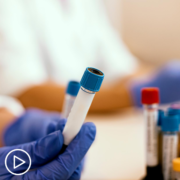What Are the Considerations When Choosing Myelofibrosis Therapy?
What Are the Considerations When Choosing Myelofibrosis Therapy? from Patient Empowerment Network on Vimeo.
When choosing a myelofibrosis treatment, how do you determine what might be best for you? Dr. Joseph Scandura shares expert advice, including a review of inhibitor therapy and stem cell transplant.
Dr. Joseph Scandura is Associate Professor of Medicine and Scientific Director of the Silver MPN Center at Weill Cornell Medicine. Learn more about Dr. Scandura, here.
Related Programs

|

Which Gene Mutations Impact Myelofibrosis Treatment Options? |

|
Transcript
Katherine Banwell:
What are the considerations when choosing treatment for myelofibrosis?
Dr. Scandura:
I would say in broad strokes, the primary considerations are the patient, what they want, the disease, what our options are, and the overall condition in terms of what are our possibilities for therapy and what is the risk/benefit of some of these different therapies. So, in myelofibrosis, although there’s been a huge amount of research over the past 10 years, really blossoming and are very impressive in, I think, an exciting way, there really are only two therapies that are approved by the FDA in the treatment of myelofibrosis, and those both affect one class of agents. These are JAK2 inhibitors, and those can be ruxolitinib (Jakafi) and fedratinib (Inrebic) are the two drugs that are approved.
Now, we have a number of therapies that have been used off-label, meaning without FDA approval, so often and for so long that they’re considered alternative standards of therapy. These can be growth factors; these can be biological agents in certain situations. And then, clinical trials is really increasingly a common therapeutic option for patients.
And then, on the most aggressive side, is hematopoietic stem cell transplant and allogeneic transplant getting blood-forming cells from another person and replacing the entire blood system through transplant.
Katherine Banwell:
So, who is right for a stem cell transplant?
Dr. Scandura:
I would say, first and foremost, an informed patient about the risks of transplant and a patient for whom a donor exists, and a good quality donor. Transplant is not an option for some people or if a donor can’t be identified, obviously.
And it’s a patient for whom the risk balance, the risk/benefit balance is tipped so that the potential toxicity, frankly, of transplant is warranted. Transplant is our most aggressive therapy. Virtually every patient will have significant side effects from transplant. Some of them are short-lived, some of them can be chronic. People die from the consequences of transplant. And so, it’s not something that is considered in patients who are necessarily doing well or are frail. The risk of transplant versus the benefit may not be in favor of transplant at that time.
My approach for transplant is to get advice from transplant physicians. I’m not a transplant physician, but I have colleagues who I refer to.
And I refer in myelofibrosis fairly universally fairly early, with the rationale being that this is information. It is not a plan; it is to speak to a transplant, what kind of donor exists. If no donor exists, then transplant is not on the table. If we have a very good, high-quality donor, then this is something that wouldn’t make the decision in itself, but it’s kind of something we can keep in our hip pocket in case we need it. And I think it’s important for patients to understand and have a full and complete discussion with a transplant physician so they understand what that means. You know, it is a significant commitment of time and morbidity, and it comes with risks.
It is also our only curative therapy. And so, it’s a double-edged sword, and I think informed patients and understanding what the options are are the gateway to any consideration of transplant.






















